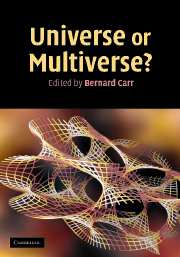Book contents
- Frontmatter
- Contents
- List of contributors
- Preface
- Acknowledgements
- Editorial note
- Part I Overviews
- Part II Cosmology and astrophysics
- 4 Cosmology and the multiverse
- 5 The anthropic principle revisited
- 6 Cosmology from the top down
- 7 The multiverse hierarchy
- 8 The inflationary multiverse
- 9 A model of anthropic reasoning: the dark to ordinary matter ratio
- 10 Anthropic predictions: the case of the cosmological constant
- 11 The definition and classification of universes
- 12 M/string theory and anthropic reasoning
- 13 The anthropic principle, dark energy and the LHC
- Part III Particle physics and quantum theory
- Part IV More general philosophical issues
- Index
- References
6 - Cosmology from the top down
Published online by Cambridge University Press: 05 July 2014
- Frontmatter
- Contents
- List of contributors
- Preface
- Acknowledgements
- Editorial note
- Part I Overviews
- Part II Cosmology and astrophysics
- 4 Cosmology and the multiverse
- 5 The anthropic principle revisited
- 6 Cosmology from the top down
- 7 The multiverse hierarchy
- 8 The inflationary multiverse
- 9 A model of anthropic reasoning: the dark to ordinary matter ratio
- 10 Anthropic predictions: the case of the cosmological constant
- 11 The definition and classification of universes
- 12 M/string theory and anthropic reasoning
- 13 The anthropic principle, dark energy and the LHC
- Part III Particle physics and quantum theory
- Part IV More general philosophical issues
- Index
- References
Summary
Problems with bottom-up approach
The usual approach in physics could be described as building from the bottom up. That is, one assumes some initial state for a system and then evolves it forward in time with the Hamiltonian and the Schrödinger equation. This approach is appropriate for laboratory experiments like particle scattering, where one can prepare the initial state and measure the final state. The bottom-up approach is more problematic in cosmology, however, because we do not know what the initial state of the Universe was, and we certainly cannot try out different initial states and see what kinds of universe they produce.
Different physicists react to this difficulty in different ways. Some — generally those brought up in the particle physics tradition — just ignore the problem. They feel the task of physics is to predict what happens in the laboratory, and they are convinced that string theory or M-theory can do this. All they think remains to be done is to identify a solution of M-theory, a Calabi—Yau or G2 manifold that will give the Standard Model as an effective theory in four dimensions. But they have no idea why the Universe should be 4-dimensional and have the Standard Model, with the values of the forty or so parameters that we observe. How can anyone believe that something so messy is the unique prediction of string theory?
- Type
- Chapter
- Information
- Universe or Multiverse? , pp. 91 - 98Publisher: Cambridge University PressPrint publication year: 2007
References
- 1
- Cited by



